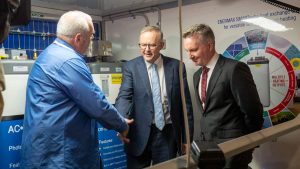Despite the closure of Hazelwood the lights stayed on, other than for places impacted by flooding. Pool prices were high though, despite moderate demand, and futures prices increased again.
A new wind farm was confirmed, taking the total wind under construction to 1.9 GW. Once again we had haphazard thought bubble style policy with Nick Xenophon, the world’s new electricity expert, getting the Federal Govt. to agree to provide a concessional loan to a proposed solar thermal plant in South Australia. As if South Australia wasn’t getting enough submarine subsidies already.
A summary of recent Federal Govt. policy, and I’m not joking, these are the actual facts, is:
- A $1 bn proposed subsidy for developing a Qld coal basin.
- The CEFC to provide assistance to an associated coal fired generation unit in Queensland to be owned by ‘Foreign investors’. Presumably the same investors that weren’t allowed to buy an electricity network in Sydney.
- Announcement of unfunded, not modelled Snowy 2 despite only owning 13% of the Snowy.
- Announcement of concessional loan to a proposed solar thermal plant in South Australia. A PPA would be far more useful than a loan but a PPA with strict performance guarantees by the proponent. The jury is very firmly out on the reliability, and LCOE of solar thermal and the prospect of a white, or should it be yellow elephant has to be considered.
- Blaming the States policies for high electricity prices, when the only new supply in 2017 is coming from those same policies.
- Moaning about the terror of renewables when their share of electricity production in Australia is small in both absolute terms and relative to the rest of the world.
- Committing to COP 21 targets but having at present zero plans or policies to deliver them. And one suspects no intention of developing real plans or policies.
- Commissioning a review but making policy announcements before the review is concluded including ruling out the policy option its chief policy advisor (the AEMC, not Nick Xenophon) and the thermal generation industry was in favour of.
I leave open to readers to form a view on whether this is the right way to go about things. Or indeed whether a satire writer could write such a stupid script.
What has the thermal industry to be scared of? It dominates production in Australia.

Turning to the weekly action
Volumes were soft this week with QLD production down 2% on the week. We suspect this is flooding of the CSG gas fields. We haven’t read about this but its know the wells are susceptible to lower production when the area floods. NSW consumption was well up and Victoria remains down.
- Future prices. Rose again with FY18 up a bit and FY19 up 2%. FY19 prices are now around $100 MWh except in Qld and despite a flat demand outlook.
- Spot electricity prices. These averaged over $100 MWh across the board. Electricity flowed from Qld to NSW and from NSW to Victoria. Victoria sent power to South Australia and Tasmania at time. We will revisit the expected change in the flow pattern in a couple of weeks.
- REC Unchanged
- Gas prices drifted further South but still remain around the $10 GJ mark in NSW
- Utility share prices. Utility shares have recovered somewhat and over the past month have typically outperformed the ASX200 Perhpaps the main share price news was IFN’s raising of $151 m equity accompanied by a 5% lift in earnings guidance to $147 m for FY17.

Share Prices


Volumes


Base Load Futures

Gas Prices


David Leitch is principal of ITK. He was formerly a Utility Analyst for leading investment banks over the past 30 years. The views expressed are his own. Please note our new section, Energy Markets, which will include analysis from Leitch on the energy markets and broader energy issues. And also note our live generation widget, and the APVI solar contribution.









